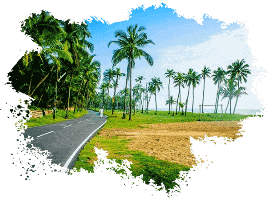
We make it possible for you to go on an adventure of a lifetime with our comprehensive guide to the best Kenyan safari adventures. We ensure you experience a perfect balance of comfort, excitement, and responsible tourism while you explore Kenya's beauty and breathtaking landscapes.
 Plan an amazing Kenyan adventure with our expertly curated safari and tour guides. From luxury sports safaris to personalized itineraries and exclusive cultural experiences, we offer perfect, eco-friendly packages through Kenya's best destinations.
Plan an amazing Kenyan adventure with our expertly curated safari and tour guides. From luxury sports safaris to personalized itineraries and exclusive cultural experiences, we offer perfect, eco-friendly packages through Kenya's best destinations.
- Expertly Curated Safari Guides: Experience the best safari parks, luxury lodges, and hidden gems tailored to your preferences for special adventures.
- Access to Exclusive Experiences: Gain priority access to luxury sports safaris, private conservancies, and authentic cultural encounters.
- Ideal Travel Support: From visa guidance to 24/7 on-ground assistance, we ensure you understand every detail, ensuring a hassle-free and luxurious safari experience.
Witu Forest Reserve: Coastal Biodiversity and Rare Birds
, Lamu County
Kenya
Witu Forest Reserve is a hidden gem along Kenya’s stunning coastline, offering visitors an extraordinary chance to immerse themselves in one of the country’s most ecologically rich and diverse environments. Nestled in Lamu County, this expansive reserve spans approximately 4,639 hectares, comprising a mosaic of habitats that range from dense woodlands and open grasslands to freshwater wetlands. These unique ecosystems provide a sanctuary for a remarkable array of wildlife, including rare bird species, endemic plants, and small mammals, making it a must-visit destination for nature enthusiasts and conservationists alike. The reserve’s coastal location contributes significantly to its biodiversity, with a climate and terrain that support species found nowhere else in Kenya. Birdwatchers, in particular, are drawn to Witu Forest for its impressive avian population, which includes elusive species such as the Sokoke Pipit, Clarke’s Weaver, and East Coast Akalat. The wetlands within the forest are vital breeding grounds for aquatic birds, adding to the area’s importance as a birdwatching haven. Beyond its avifauna, the forest teems with life, from playful monkeys in the canopy to antelopes grazing in the underbrush. For travelers seeking a tranquil escape, Witu Forest Reserve offers more than just natural beauty it’s a testament to ecological harmony and conservation success. The serenity of the forest, punctuated by the sounds of birdsong and rustling leaves, provides an ideal setting for guided nature walks, eco-tours, and immersive wildlife experiences in the coastal region similar to Shimba Hills adventures and safaris. With its rich biodiversity and significant ecological role, Witu Forest Reserve is not only a haven for wildlife but also an inspiring reminder of the importance of preserving our natural world.
Discovering the Unique Ecosystem of Witu Forest Reserve
 Witu Forest Reserve is renowned for its rich and diverse ecosystem that supports an impressive variety of flora and fauna. This coastal forest is a unique ecological haven, combining dense woodlands, expansive grasslands, and thriving freshwater wetlands. These varied habitats create a vibrant environment that is critical for the survival of both resident and migratory species. The forest’s location within Kenya’s coastal belt enhances its ecological significance, as it provides a rare refuge for species that thrive in such specialized environments. Birdlife is one of the most celebrated features of Witu Forest Reserve. The forest is a magnet for birdwatchers from across the globe, offering opportunities to spot rare and endangered species such as the Sokoke Pipit, Clarke’s Weaver, and East Coast Akalat. The wetlands are particularly important, serving as vital breeding grounds for aquatic birds and supporting diverse avian populations year-round. For first-time visitors, the sight and sounds of these birds provide an unforgettable experience. Beyond its avian wonders, the forest teems with other wildlife that thrives in its lush undergrowth and canopy. Visitors can expect to encounter playful monkeys swinging through the trees, shy antelopes grazing in the grasslands, and small carnivores stealthily moving through the forest floor. This dynamic interplay of species underscores the biodiversity that makes Witu Forest so extraordinary. For those with a keen interest in plants, the forest also boasts an impressive array of indigenous vegetation. These plants play an essential role in maintaining the ecological balance, from stabilizing the soil to providing food and shelter for the wildlife. Guided tours often highlight the medicinal and cultural uses of these plants, offering a deeper appreciation of their significance. Witu Forest Reserve’s ecosystem is not just an attraction; it’s a critical component of Kenya’s environmental heritage. Its diverse habitats and the species they support make it an irreplaceable treasure for both conservation and ecotourism
Witu Forest Reserve is renowned for its rich and diverse ecosystem that supports an impressive variety of flora and fauna. This coastal forest is a unique ecological haven, combining dense woodlands, expansive grasslands, and thriving freshwater wetlands. These varied habitats create a vibrant environment that is critical for the survival of both resident and migratory species. The forest’s location within Kenya’s coastal belt enhances its ecological significance, as it provides a rare refuge for species that thrive in such specialized environments. Birdlife is one of the most celebrated features of Witu Forest Reserve. The forest is a magnet for birdwatchers from across the globe, offering opportunities to spot rare and endangered species such as the Sokoke Pipit, Clarke’s Weaver, and East Coast Akalat. The wetlands are particularly important, serving as vital breeding grounds for aquatic birds and supporting diverse avian populations year-round. For first-time visitors, the sight and sounds of these birds provide an unforgettable experience. Beyond its avian wonders, the forest teems with other wildlife that thrives in its lush undergrowth and canopy. Visitors can expect to encounter playful monkeys swinging through the trees, shy antelopes grazing in the grasslands, and small carnivores stealthily moving through the forest floor. This dynamic interplay of species underscores the biodiversity that makes Witu Forest so extraordinary. For those with a keen interest in plants, the forest also boasts an impressive array of indigenous vegetation. These plants play an essential role in maintaining the ecological balance, from stabilizing the soil to providing food and shelter for the wildlife. Guided tours often highlight the medicinal and cultural uses of these plants, offering a deeper appreciation of their significance. Witu Forest Reserve’s ecosystem is not just an attraction; it’s a critical component of Kenya’s environmental heritage. Its diverse habitats and the species they support make it an irreplaceable treasure for both conservation and ecotourism
Experience the Birdwatching and Unique Birds in Witu Forest
Witu Forest Reserve is a paradise for bird enthusiasts, boasting an impressive variety of bird species that thrive in its diverse habitats. Among the highlights are rare and endangered species such as the Sokoke Pipit, Clarke’s Weaver, and East Coast Akalat. These birds are not only unique to Kenya but also hold global conservation importance, attracting ornithologists and casual birdwatchers alike. The Witu reserve’s wetlands are a vital breeding ground for aquatic birds, hosting migratory species that travel thousands of kilometers to nest here between November and April. Visitors during this period can witness the vibrant activity of birds feeding, nesting, and raising their young. Other notable bird species include colorful kingfishers, bee-eaters, and hornbills, which add to the rich tapestry of avian life. Birdwatchers can expect to hear the melodic calls of these species as they explore the forest’s trails. Guided birdwatching tours are highly recommended, as expert guides help visitors identify elusive birds while providing insights into their behaviors, habitats, and ecological roles. Whether it’s spotting the bright plumage of a sunbird flitting through the trees or observing the synchronized movements of migratory flocks, each birdwatching experience at Witu Forest is truly captivating. For photography enthusiasts, the opportunities are endless. The interplay of light filtering through the forest canopy creates stunning backdrops for capturing these remarkable birds in their natural habitats. With its unparalleled diversity and beauty, Witu Forest Reserve stands as one of Kenya’s premier destinations for birdwatching, in the coastal Kenya just like the Ngomeni Salt flats birdwatching and photography, offering unforgettable experiences for both seasoned ornithologists and first-time visitors.
What Activities Can You Do in Witu Forest Reserve?
Visitors to Witu Forest Reserve can engage in a variety of activities that showcase the beauty, biodiversity, and ecological importance of this remarkable natural sanctuary. From thrilling wildlife encounters to serene relaxation spots, the reserve offers experiences that cater to a wide range of interests and age groups. Each activity provides an opportunity to connect deeply with nature while appreciating the delicate balance of this vital ecosystem. Whether you are a first-time visitor or a seasoned traveler, Witu Forest promises immersive adventures that leave lasting impressions. The following activities are designed to highlight the diverse experiences awaiting visitors in this pristine environment:
- Birdwatching: With over 200 bird species recorded in the reserve, Witu Forest is a paradise for bird enthusiasts. Guided birdwatching tours allow visitors to explore specific hotspots where rare and elusive species such as the Sokoke Pipit, Clarke’s Weaver, and East Coast Akalat are commonly sighted. Experienced guides provide insights into bird behavior, habitats, and conservation challenges, enhancing the experience for both beginners and seasoned birders. The wetlands within the forest are especially vibrant, hosting migratory birds during November to April, making this period an exceptional time to visit.
- Guided Nature Walks: Explore the forest on foot with experienced guides who provide in-depth knowledge about the reserve’s diverse flora and fauna. These walks take visitors through dense woodlands, open grasslands, and wetland areas, offering an immersive experience that highlights the interconnectedness of the ecosystem. Expect to encounter towering indigenous trees, vibrant butterflies like in Kinale Forest, and even playful monkeys. First-time visitors will appreciate the educational aspect of these walks, which also emphasize the importance of conservation efforts to preserve such ecosystems.
- Eco-Tours: For a comprehensive understanding of the reserve’s ecological significance, eco-tours offer a deeper exploration of Witu Forest. These tours often include community visits, showcasing how local residents benefit from and contribute to conservation initiatives. Activities may include learning about traditional uses of forest plants for medicine and food, as well as understanding sustainable practices that protect both livelihoods and biodiversity. Eco-tours are ideal for visitors who want to connect with both the environment and the local culture.
- Photography Safaris: The diverse landscapes and wildlife of Witu Forest make it a photographer’s dream destination. Capture stunning shots of rare bird species, expansive wetlands, and the serene interplay of light filtering through dense forest canopies. Photographers can also document the behaviors of wildlife such as antelopes grazing or monkeys swinging through the trees, creating vivid memories of this unique environment.
- Picnicking: Designated picnic areas within the reserve provide tranquil spots for visitors to relax and enjoy a meal amidst the sounds of nature. These spots are shaded by large indigenous trees, creating a cool and peaceful ambiance. Families and groups often use this opportunity to unwind after a hike or birdwatching excursion, while soaking in the beauty of their surroundings.
- Educational Programs: Witu Forest also hosts programs designed for students and researchers, focusing on biodiversity, conservation strategies, and sustainable forest management. These programs offer visitors a chance to gain a deeper appreciation of the forest’s ecological importance while contributing to ongoing education and awareness efforts.
By participating in these activities, visitors can fully immerse themselves in the wonders of Witu Forest Reserve, gaining not only unforgettable experiences but also a greater understanding of the need to preserve such natural treasures.
Why is Witu Forest Reserve Important?
Witu Forest Reserve is a cornerstone of Kenya’s environmental conservation efforts, playing a vital role in preserving the country’s coastal ecosystems. The reserve’s diverse habitats support a wide range of rare and endangered species, including birds, mammals, and plants that are unique to this region. This makes it an irreplaceable area for biodiversity preservation and a critical refuge for species that thrive in specialized environments. By protecting these habitats, the reserve ensures the survival of countless species that might otherwise face extinction. One of the most significant ecological functions of Witu Forest Reserve is its role as a carbon sink. The forest absorbs substantial amounts of carbon dioxide from the atmosphere, helping to mitigate the impacts of climate change. This natural process not only benefits the local environment but also contributes to global climate regulation. Additionally, the reserve’s dense vegetation and wetlands play an essential role in water filtration, ensuring clean and safe water for surrounding communities. These wetlands also regulate water flow, reducing the risk of floods during heavy rains and sustaining agricultural activities in the region during drier periods. Beyond its environmental contributions, Witu Forest Reserve provides invaluable ecosystem services that directly benefit local populations. The forest stabilizes soils, preventing erosion and maintaining the fertility of agricultural lands nearby. These services are vital for the livelihoods of local communities who depend on farming and natural resources. Moreover, the reserve’s ecotourism initiatives, such as guided nature walks and birdwatching tours, just like exploring Kaya forest generate sustainable economic opportunities for the surrounding communities, fostering a shared sense of responsibility for the forest’s protection. In essence, Witu Forest Reserve is not just a sanctuary for wildlife; it is a living example of how conservation and human livelihoods can coexist. Its ecological and economic importance underscores the need for continued efforts to protect and preserve this unique natural treasure for generations to come.
How to Plan Your Visit to Witu Forest Reserve
Witu Forest Reserve is not only a haven for wildlife but also a destination that fosters appreciation and understanding of Kenya’s unique coastal ecosystems. Homejoy Safari Adventures offers tailored eco-tours to Witu Forest, providing visitors with a chance to explore this serene and ecologically significant reserve. Plan your visit today and immerse yourself in the beauty and biodiversity of Witu Forest Reserve. Visiting Witu Forest Reserve requires careful planning to ensure a fulfilling and enjoyable experience while appreciating its ecological richness. Here are some detailed tips to help you make the most of your adventure:
- Timing: The optimal time to visit Witu Forest Reserve is between November and April, coinciding with the presence of migratory birds that flock to the wetlands. During this period, the forest comes alive with vibrant bird activity, offering an unparalleled birdwatching experience. Early mornings and late afternoons are particularly rewarding, as the cool temperatures make for pleasant walks and wildlife encounters.
- What to Bring: Ensure you pack appropriately for the forest environment. Lightweight and breathable clothing is ideal for navigating the humid conditions, while sturdy walking shoes provide comfort on uneven trails. Don’t forget essentials such as binoculars for birdwatching, a camera to capture the stunning scenery and wildlife, sunscreen to protect against the coastal sun, and insect repellent to guard against mosquitoes and other insects. Carry sufficient water in a reusable bottle to stay hydrated throughout your exploration.
- Respect Nature: Witu Forest Reserve is a protected area, and it’s crucial to minimize human impact. Stick to designated trails to avoid disturbing the forest floor and its inhabitants. Avoid littering and instead carry all waste back with you to maintain the pristine environment. Keep a safe distance from wildlife to ensure their natural behaviors are not disrupted, and refrain from making loud noises that might startle animals or birds.
These considerations not only enhance your visit but also contribute to the conservation efforts that protect this unique ecosystem. By planning thoughtfully, you can fully immerse yourself in the beauty and biodiversity of Witu Forest Reserve while respecting its ecological integrity.
Frequently Asked Questions (FAQs) for Oloolua Nature Trail
1. What is Oloolua Nature Trail? Oloolua Nature Trail is a 5-kilometer scenic trail located in the serene Karen suburb of Nairobi. It is known for its rich biodiversity, historic Mau Mau caves, monumental trees, and picturesque waterfall, making it a perfect destination for nature lovers and history enthusiasts.
2. What activities can I do at Oloolua Nature Trail? Visitors can enjoy activities such as hiking, birdwatching, photography, picnicking, and guided educational tours. The trail’s well-marked paths, serene picnic spots, and abundant wildlife provide an immersive experience in nature.
3. Where is Oloolua Nature Trail located? Oloolua Nature Trail is situated in Karen, Nairobi, approximately 20 kilometers from Nairobi’s city center. It is easily accessible by car or public transport, making it a convenient getaway for residents and visitors.
4. Is there an entry fee for Oloolua Nature Trail? Yes, Oloolua Nature Trail charges a nominal entry fee to visitors. The fee supports conservation efforts and the maintenance of the trail, ensuring a safe and enjoyable experience for everyone.
5. What should I bring when visiting Oloolua Nature Trail? Pack essentials like comfortable hiking shoes, sunscreen, insect repellent, a reusable water bottle, and a camera for capturing the trail’s beauty. Binoculars are recommended for birdwatching enthusiasts.
6. Are guides available at Oloolua Nature Trail? Yes, knowledgeable local guides are available and highly recommended. They provide valuable insights into the trail’s history, biodiversity, and conservation efforts, enhancing your visit.
7. What is the best time to visit Oloolua Nature Trail? The best time to visit is during the dry seasons, from June to October and January to February. These months offer pleasant weather and better trail accessibility for hiking and outdoor activities.
8. Can families with children visit Oloolua Nature Trail? Absolutely! Oloolua Nature Trail is family-friendly, offering easy-to-navigate paths, picnic areas, and a serene environment that both adults and children can enjoy.